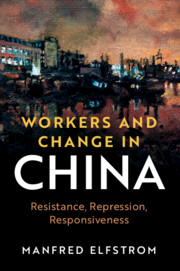Book contents
- Workers and Change in China
- Cambridge Studies in Contentious Politics
- Workers and Change in China
- Copyright page
- Dedication
- Contents
- Figures
- Maps
- Tables
- Acknowledgments
- 1 Introduction
- 2 Recipes for Resistance
- 3 Bureaucratic Incentives
- 4 Orthodox Control
- 5 Risk-Taking Control
- 6 Increased Repressive and Responsive Capacity
- 7 Bottom-Up versus Top-Down Change
- 8 Conclusion
- Appendices
- References
- Index
- Series page
5 - Risk-Taking Control
Published online by Cambridge University Press: 14 January 2021
- Workers and Change in China
- Cambridge Studies in Contentious Politics
- Workers and Change in China
- Copyright page
- Dedication
- Contents
- Figures
- Maps
- Tables
- Acknowledgments
- 1 Introduction
- 2 Recipes for Resistance
- 3 Bureaucratic Incentives
- 4 Orthodox Control
- 5 Risk-Taking Control
- 6 Increased Repressive and Responsive Capacity
- 7 Bottom-Up versus Top-Down Change
- 8 Conclusion
- Appendices
- References
- Index
- Series page
Summary
The previous chapter on the Yangtze River Delta began with a short anecdote concerning a dinner party. The Pearl River Delta, in contrast, requires at least two stories to start things off. The first takes place in a very different setting: the backstreets of Zhongshan, a manufacturing center across the mouth of the Pearl River from Shenzhen and abutting the gambling center of Macau. I made two brief trips to Zhongshan in the spring of 2015. The reason for my trips: employees of a Japanese-owned handbag factory in an outlying district of the city had become frustrated at their low wages and lack of social security contributions and, moreover, were concerned that cutbacks in their work hours might portend layoffs. As they had before when they came up against otherwise unresolvable grievances, the workers responded by going on strike. Unlike in their previous mobilizations, however, the workers were met with a violent crackdown. On my initial visit to the handbag factory, a worker chatting in a convenience store across the street explained to me what happened: “People were beaten … They were beaten by people in military-style uniforms. I don’t know if they were police or mafia. [It happened] when we were all gathered outside, [and] the police and labor bureau people just laughed at us. How can you not do anything for people and then just laugh at them? It was so cruel!” (Interview 60). Nor apparently was it just workers who had been attacked. I read online that NGO activists who had gone to the strikers’ aid were brutalized by plainclothes policemen. One subsequently had to be treated for a lumbar disc protrusion. On my follow-up visit to the factory, workers were streaming out of negotiations with factory management. The discussions had already dragged on a month. But the intimidation continued. The workers pointed out a thuggish individual loitering outside the plant’s gates: “That man with the phone there was responsible for beating people up; he takes revenge on people” (Group Interview 61).
- Type
- Chapter
- Information
- Workers and Change in ChinaResistance, Repression, Responsiveness, pp. 87 - 109Publisher: Cambridge University PressPrint publication year: 2021



